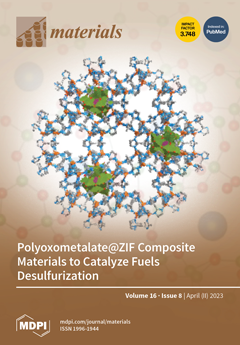Silver electrodes are commonly used as a conductive layer for electromagnetic devices. It has the advantages of good conductivity, easy processing, and good bonding with a ceramic matrix. However, the low melting point (961 °C) results in a decrease in electrical conductivity and
[...] Read more.
Silver electrodes are commonly used as a conductive layer for electromagnetic devices. It has the advantages of good conductivity, easy processing, and good bonding with a ceramic matrix. However, the low melting point (961 °C) results in a decrease in electrical conductivity and migration of silver ions under an electric field when it works at high temperatures. Using a dense coating layer on the silver surface is a feasible way to effectively prevent the performance fluctuation or failure of the electrodes without sacrificing its wave-transmitting performance. Calcium-magnesium-silicon glass-ceramic (CaMgSi
2O
6) is a diopside material that has been widely used in electronic packaging materials. However, CaMgSi
2O
6 glass-ceramics (CMS) are facing tough challenges, such as high sintering temperature and insufficient density after sintering, which significantly confine its applications. In this study, CaO, MgO, B
2O
3, and SiO
2 were used as raw materials to manufacture a uniform glass coating on the silver and Al
2O
3 ceramics surface via 3D printing technology followed by high-temperature sintering. The dielectric and thermal properties of the glass/ceramic layer prepared with various CaO-MgO-B
2O
3-SiO
2 components were studied, and the protective effect of the glass-ceramic coating on the silver substrate at high temperatures were evaluated. It was found that the viscosity of the paste and the surface density of the coating increase with the increase of solid contents. The 3D-printed coating shows well-bonded interfaces between the Ag layer, the CMS coating, and the Al
2O
3 substrate. The diffusion depth was 2.5 μm, and no obvious pores and cracks can be detected. According to the high density and well-bonded glass coating, the silver was well protected from the corrosion environment. Increasing the sintering temperature and extending the sintering time is beneficial to form the crystallinity and the densification effect. This study provides an effective method to manufacture a corrosive-resistant coating on an electrically conductive substrate with outstanding dielectric performances.
Full article






